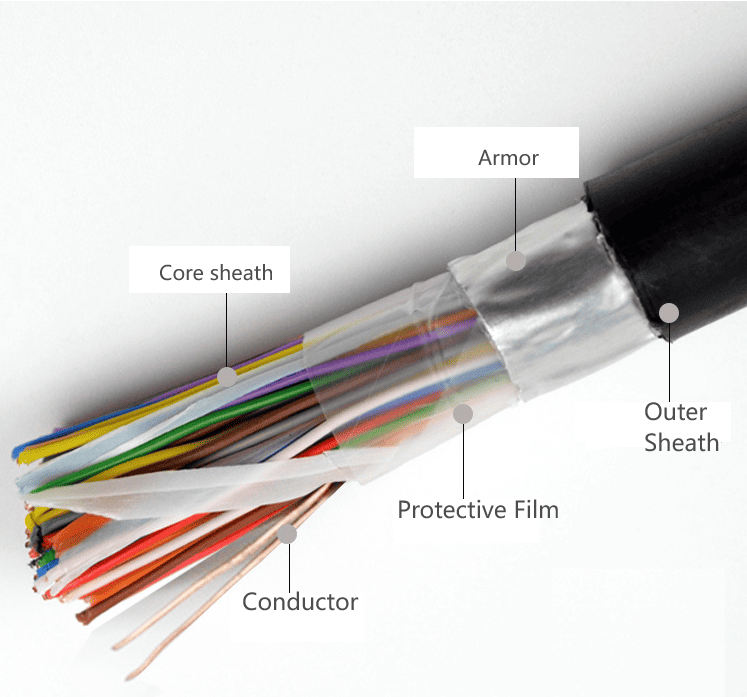PE vs. PVC Telecom Cables: How to Choose the Right Jacket for HYA 50×2×0.4 Cables

Why Jacket Material Matters for HYA 50×2×0.4 Cables
The HYA 50×2×0.4 telecom cable, with its 50-pair twisted structure and 0.4mm oxygen-free copper conductors, is a backbone for voice and data networks. However, choosing between PE (polyethylene) and PVC (polyvinyl chloride) jackets dramatically impacts its lifespan and performance. Here’s how to decide:
HYA 50×2×0.4 Cables: Core Specifications
- Conductors: 0.4mm oxygen-free copper (99.9% conductivity, <3dB/100m loss).
- Pairs: 50 twisted pairs, optimized for low crosstalk and EMI resistance.
- Standards: Complies with TIA/EIA-568 and ISO 11801 for telecom networks.
PE vs. PVC Jackets for HYA 50×2×0.4: A Data-Driven Comparison
|
Property |
HYA with PE Jacket |
HYA with PVC Jacket |
|
Environment |
Outdoor, harsh climates |
Indoor, controlled environments |
|
Temperature |
-60°C to 80°C |
-20°C to 60°C |
|
UV Resistance |
Excellent (no degradation) |
Poor (requires UV stabilizers) |
|
Flexibility |
High (ideal for aerial/direct burial) |
Moderate (suits conduits) |
|
Cost |
20-30% higher |
Budget-friendly |
Source: Yuado Industrial testing data & IEC 60502 standards
When to Choose HYA 50×2×0.4 with PE Jacket
- Outdoor Deployments:
- Case Study: Guangzhou’s public surveillance network used PE-jacketed HYA cables to withstand monsoon rains and 90% humidity, reducing maintenance costs by 35% over 3 years.
- 5G Readiness: PE’s UV resistance ensures stable signal transmission for outdoor small cell networks.
- Industrial Zones:
- Resists oil, acids, and alkalis in petrochemical plants or ports.
- Long-Term ROI:
- PE jackets extend cable lifespan to 15-20 years vs. PVC’s 8-12 years outdoors.
When to Choose HYA 50×2×0.4 with PVC Jacket
- Indoor Telecom Networks:
- Case Study: A Shenzhen office complex used PVC-jacketed HYA cables for fire-safe VoIP and LAN systems, passing IEC 60332 flame tests.
- Cost Savings: PVC reduces upfront costs by 25% for large-scale indoor projects.
- Short-Term Flexibility:
- Easier to install in tight spaces like server rooms or cable trays.
- Temporary Setups:
- Trade shows, event venues, or modular offices.
Key Decision Factors for HYA 50×2×0.4 Cables
- Environmental Challenges:
- PE: Rain, snow, UV exposure, chemicals.
- PVC: Indoor heat, fire safety requirements.
- Regulatory Compliance:
- PE: Meets ISO 11801 for outdoor use.
- PVC: Complies with RoHS and LSZH (Low Smoke Zero Halogen) standards.
- Budget vs. Lifespan:
- PE: Higher initial cost but lower lifetime maintenance.
- PVC: Lower cost but may require earlier replacement.
Industry Insights: PE vs. PVC Trends
- 5G Expansion: Demand for PE-jacketed HYA cables grows at 7% CAGR (Frost & Sullivan) for outdoor 5G macro/micro cells.
- Smart Buildings: PVC remains dominant (55% market share) for indoor structured cabling (Grand View Research).
FAQs: HYA 50×2×0.4 Jacket Selection
Q: Can I use PVC-jacketed HYA cables outdoors?
A: Only with UV-resistant coatings, but PE is recommended for long-term reliability.
Q: Does PE affect HYA cable flexibility?
A: No—PE offers high flexibility, making it suitable for aerial or buried installations.
Q: Which jacket is better for fire safety?
A: PVC with LSZH additives meets strict indoor fire codes.
Conclusion
The HYA 50×2×0.4 telecom cable delivers exceptional signal integrity, but its performance hinges on jacket material. For outdoor durability and 5G readiness, PE is unmatched. For indoor cost efficiency and fire safety, PVC is ideal. Tailor your choice to project needs and environmental demands.
for more details, welcome to check our products as ref:
https://cloudtopcable.com/products/hya-50204mm
Leave a Reply
- HYA 50×2×0.4 Communication Cable: Reliable Solution for Guangzhou Surveillance Systems
- Why Does Your EV Stop Charging Suddenly? Let’s Troubleshoot!
- Yuedao Intelligent Empowers Guangzhou Metro to Set World Record for Fastest Subway Speed
- Become Our Local Partner - Expand Your Market with High-Quality Cables & Wires
